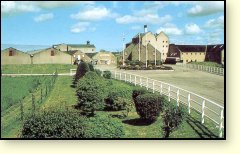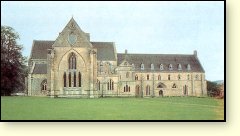
 |
|
Location: Elgin, Morayshire IV30 3TQ
Roads: Off the B9010 south of Elgin
Hours: Mon - Thurs • All visits by appointment
|
Elgin had gained and lost considerable nobility and sophistication long before Columbus crossed to the New World; its cathedral, begun in the 1100s, showed soaring grace before its destruction, and the town was a favoured Royal Burgh in the 1200s. Part of a 1687 carved stone in the cathedral graveyard reads, ‘If lyfe were a thing that monie could buy the poor could not live and the rich could not die.’ Elegant buildings from the 17th and 18th centuries scattered here and there give a pleasing serendipity touch to town walks. Some of the best barley in Britain is cropped in the surrounding fields.
p>Pluscarden Priory dates from 1236 and over the centuries on New Year’s Day the Benedictine abbots used to bless the waters of the Black Burn where Miltonduff distillery now stands. It is not out of the question that the production of aqua vitae was carried out there by the monks, particularly since religious orders in Ireland and south-west Scotland seem to have been guardians of the secrets of distillation since the Dark Ages. Moreover, the distillery buildings were once a meal-mill run by the monks at the priory.
In the years before Miltonduff was built in 1824, wisps of smoke regularly rose from hollows all over the surrounding glen, each the signature of a fire boiling an illicit still. The distillery was one of the new generation of such businesses born after the 1823 Excise Act. In the 1860s it was owned for a time by James Grant who owned Highland Park in Orkney. In 1895, it was extended and it may well have been then that the stone upon which the abbot knelt during his ceremonies was built into the support wall of one of the stills. The Catholic Church was given a further brief direct interest in Miltonduff; in 1900 the Elgin parish was bequeathed a share of the ownership, but these were difficult times in whisky making and the stock was sold on soon after. The distillery was substantially rebuilt in 1974/75 and is now the largest of the distilleries owned by the Allied Distillers group. ‘Duff’ was added to the name when the land on which the distillery stood was bought by the Duff family, the Dukes of Fife. Miltonduff has kept alive the agricultural dimension to distilling that goes back to the days when whisky making was a part-time perk for farmers. The company still owns and runs the farms around the distillery.
In 1964 a pair of Lomond stills was installed, the spirit of which was named Mosstowie, but they were removed in 1981. There are now three pairs shaped in the traditional Miltonduff configuration. Miltonduff used to be triple-distilled, a final vestige of the old routine when stills were a little less efficient than they are today.
The Whisky
Petal-fragrant, sweetly sappy gentle style of malt with a little smoke and a touch of vanilla. Standard issue is 12-year-old at 43% vol. and there is also some 13-year-old in circulation. Miltonduff is the main malt in Ballantine’s blended whiskies.
Source of water
Loch Moray
Of interest

Pluscarden Priory was founded in 1236 by Benedictine monks. It is likely that they held many of the secrets of the distillation process.
|
• Pluscarden Abbey mouldered after the Reformation but was revived in 1948. Promotion from priory to abbey status took place in 1973.